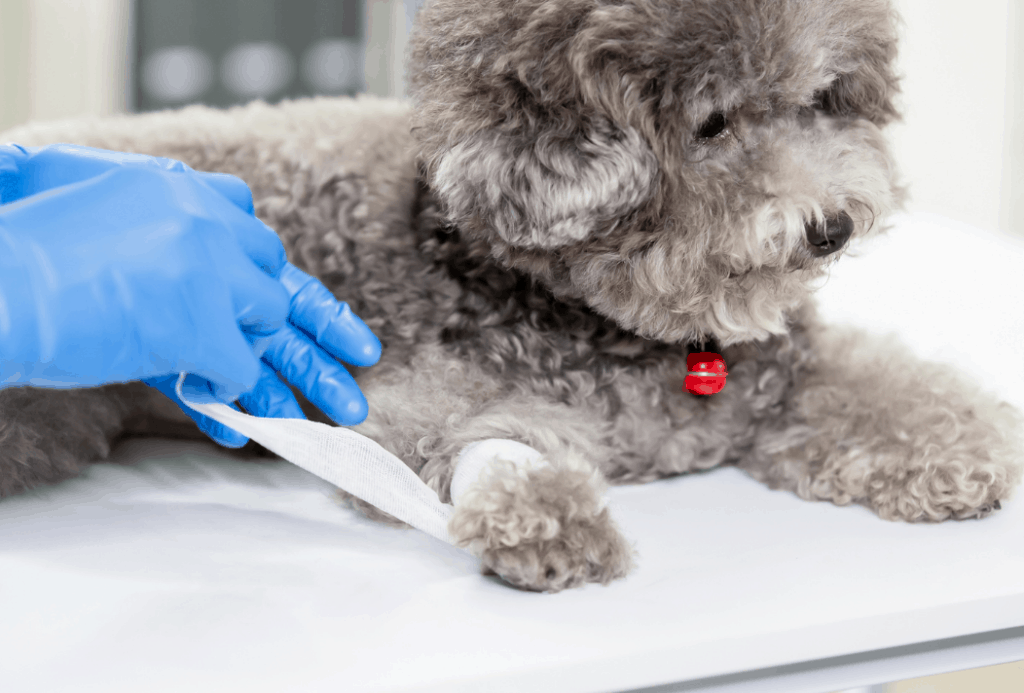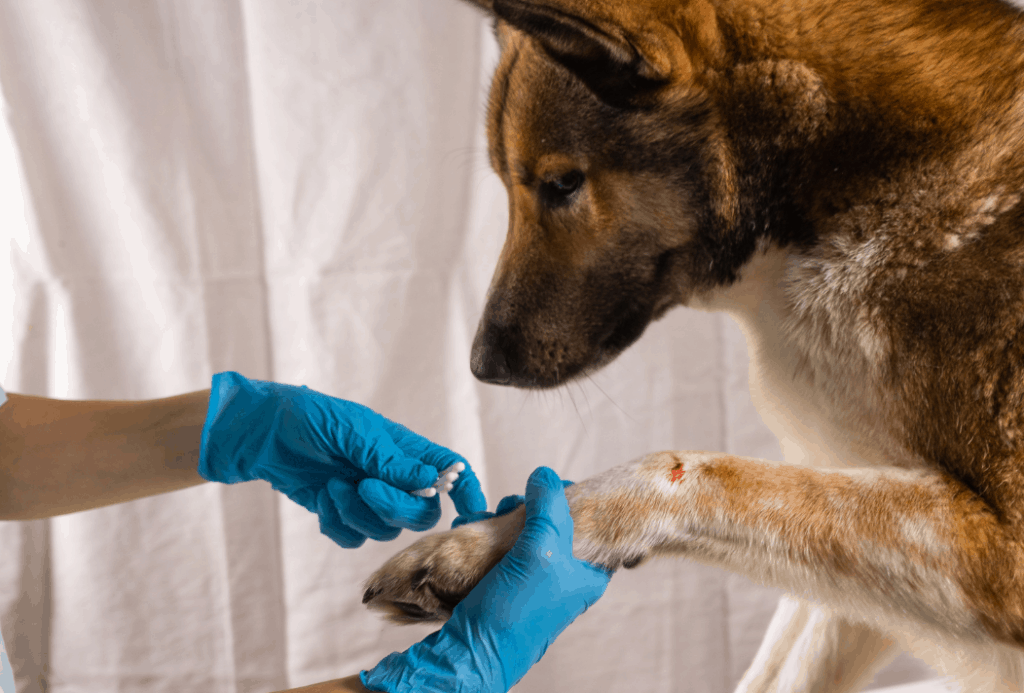How to Treat your Dog’s Wounds at Home
When your dog is injured it can be a stressful situation for both you and your pup. To help ease everyone’s anxiety, it is best to know a little bit about first aid, wound care at home, and how soon you need to contact your veterinarian. Your dog’s speedy recovery can be all thanks to a little extra knowledge that you take on as a pet parent.
In this article we look at some of the common wounds that our canine friends experience and the associated at home first aid tips for dogs. With home wound care, sometimes the most important skill you can have as a dog owner is judging how urgently you need to take your pup to see a professional. We’ll give you some tips on that too!
What are some common skin injuries in dogs?
Toenail injuries
One of the most common injuries that we’ll see are toenail injuries. Excited puppies can get their long claws caught on fabric or carpeting. Adult dogs can do this, too, or they break a toenail from playing too hard on solid surfaces. Some toenails break at the tip, but if the quick is involved, you will see bleeding.
The quick is the pink tissue found inside of the solid base, and it is composed of capillaries that bleed when cut or ripped.
How to treat toenail injuries
When this happens, or if you accidentally clip the quick while cutting your pet’s nails, it is best to keep styptic powder on standby. This is a product that helps to clot the bleeding quick when you pack it into the cut nail. If you don’t have any handy, corn starch is a suitable replacement.
Abrasions
Dogs can also have abrasions like people can. An abrasion is where some of the skin has been scraped away, usually by a rough surface or due to traumatic events like falling from a moving vehicle. Abrasions are very superficial and may bleed slightly.
How to treat abrasions
It is safe to clean these wounds with warm, soapy water, and topical antiseptic ointments like Neosporin or mupirocin are typically safe to use in these situations.
Lacerations
Lacerations involve sharp cuts into the skin. If the laceration is deep and under a lot of surface tension, the wound itself can appear very wide and expose underlying tissues like muscle or bone.
How to treat lacerations
For very small lacerations that are superficial and only one to two millimeters wide, you can clean the area with warm, soapy water and apply ointment directly. For bigger or deep lacerations, you will need to cover the site with a loose-fitting cloth or article of clothing and head to your veterinarian.
Puncture wounds or bites
Puncture wounds are most commonly caused by animal bites. They can be inflicted during fights or from rough play. Puncture wounds can be superficial or deep, but regardless, it is possible for bites to become severely infected due to the types of bacteria present in an animal’s mouth.
How to treat puncture puncture wounds
Bites should be disinfected in a manner similar to what is described above, but all bites should eventually be evaluated by a veterinarian as it is likely that antibiotics will need to be prescribed.
Burns
Burns happen a little less frequently than other wound types. Whether it is a sunburn, or your pup was accidentally splashed with hot water, burns can vary in severity from first degree to third degree burns. First degree burns are superficial burns that cause redness on the skin’s surface. Second degree burns are slightly deeper but don’t penetrate down to the subcutaneous layer and can develop blisters. Third degree burns involve all of the skin’s layers and can take a long time to heal,
How to treat burns Burns
Silver sulfadiazine is a thick type of topical ointment that is great for burns and blisters. Third degree burns may need surgical intervention or skin grafting.
First aid tips for treating dog wounds
Clean with warm soapy water
Superficial wounds usually have minor redness and little to no bleeding present. In these cases, it is safe to clean the site with warm, soapy water and then pat it dry with a clean towel. Diluted chlorhexidine scrub or diluted iodine (to the color of weak tea) can also be used to disinfect wounds.
Use topical ointments
Topical ointments like Neosporin and mupirocin are antibiotic ointments that can safely be applied to many different types of wounds.
Apply pressure
If the wound is slightly bleeding, apply gentle pressure with a clean cloth or some sterile gauze bandaging, if you have it.

Avoid certain liquids
Avoid using liquids like rubbing alcohol and hydrogen peroxide. Alcohol can be very stinging, and both alcohol and hydrogen peroxide can destroy healthy cells.
Cornstarch
Keep styptic powder or cornstarch handy for toenail injuries.
Warm and cold packs
Sometimes warm or cold compresses can help certain kinds of injuries. These are mostly for orthopedic issues and swelling, in which case, compresses can provide comfort. Cold compresses are especially useful for burn injuries and abrasions. You can use an ice pack or some ice cubes in a Ziploc bag, wrap the pack in a towel, and then apply the compress to the affected area. If your pup will tolerate it, keep it in place for three to five minutes and repeat these two or three times per day.
When to see a vet and why
Very minor burns and superficial wounds can improve with simple first aid. However, for wounds lasting longer than two to three days, or for non-superficial wounds, you will need to make an appointment with your veterinarian. If bleeding is severe (like when an artery and vein are cut) or if bleeding persists for more than five to ten minutes, you should contact your veterinarian right away.
They can determine if the wound appears infected and may recommend a culture swab to see what kind of bacteria is present. This is especially useful for non-healing wounds because the right class of antibiotic can be determined this way.

What types of wound care will your dog receive at the veterinarian?
Skin testing and oral antibiotics
Sometimes, simple in-house skin testing can help guide which antibiotic your vet will choose. Oral antibiotics are great because they address the infection from within the body while topical therapy helps from the outside.
Anti inflammatories or steroid creams
If a wound is inflamed or painful, non-steroidal anti-inflammatories can help alleviate pain. For deep scratches and skin infections associated with allergies, short-term use of a steroid medication can provide relief. There are also lots of anti-itch therapies available today such as Apoquel and Cytopoint.
Prescription topical ointments
Topical ointments come in many different varieties. Silver sulfadiazine is a thick type of topical ointment that is great for burns and blisters. It can be kept out at room temperature, but you can also keep it in your fridge so that the coolness provides further relief. Other ointments prescribed by your vet may contain topical antifungal or anti-inflammatory ingredients.
Surgery or skin grafting
For very deep or non-healing wounds, surgical debridement or skin grafting may be necessary. There are also special kinds of bandage techniques that can help promote the growth of healthy tissue known as granulation tissue. Then, once there is enough healthy tissue, a larger wound can be surgically closed.
Cold laser therapy
Cold laser therapy, which is the use of specific light frequencies to help heal wounds, is available at some veterinary hospitals. Specialty hospitals can make use of other healing techniques such as acupuncture and hyperbaric oxygen chamber therapy.
Remember, wound treatment can greatly vary from case to case
First aid and basic wound care knowledge can be very useful in many situations. If you’re still unsure about the right approach to wound care, it is always best to contact your veterinarian for further recommendations.
The post How to Treat your Dog’s Wounds at Home appeared first on VetBabble.





Post a Comment